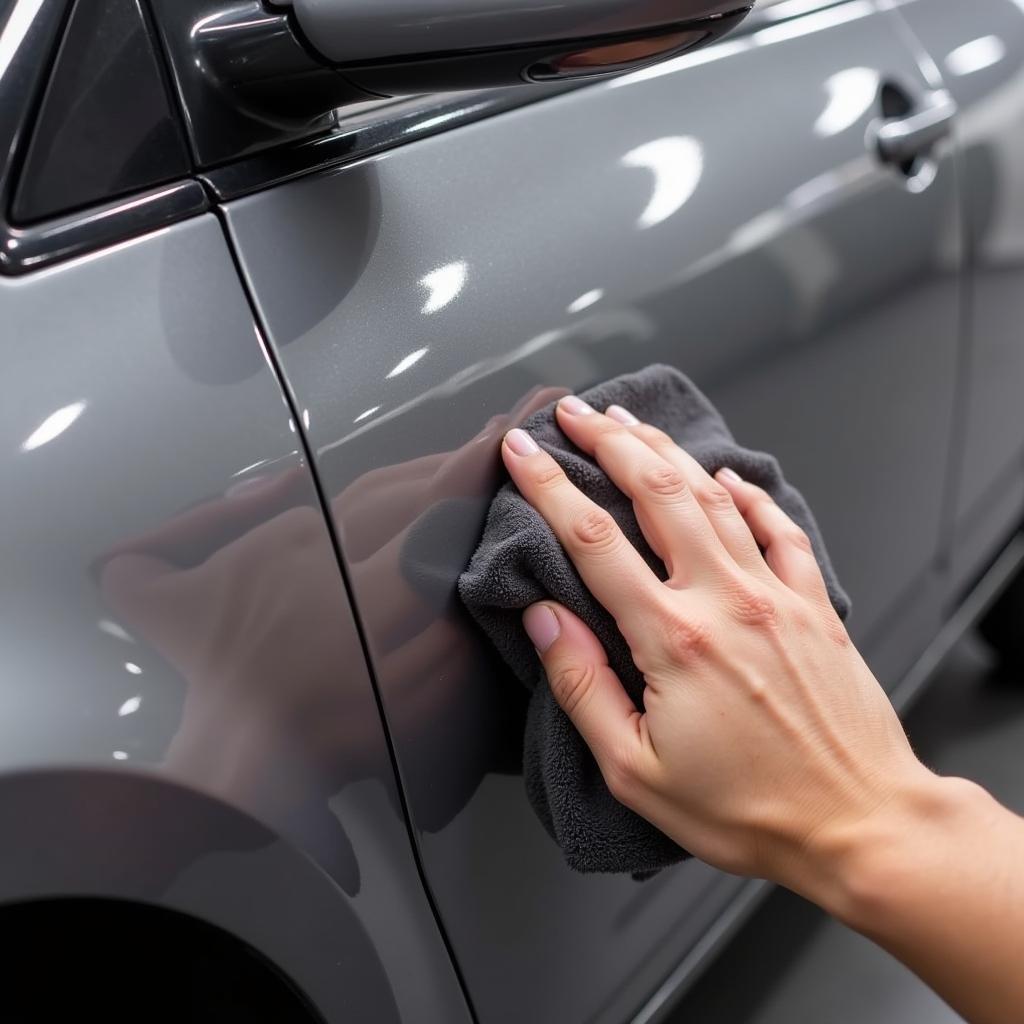Car paint damage, whether a minor scratch or a deep gouge, can be an eyesore. It’s more than just cosmetic; untreated paint chips can lead to rust, further damaging your vehicle. This guide provides comprehensive, practical advice on how to fix your car paint damage and restore its pristine appearance.
Similar to fixing paint scratches on car cost, DIY repairs offer a cost-effective solution. Let’s explore the different types of car paint damage and how to tackle them.
Identifying the Type of Car Paint Damage
Before you start, it’s crucial to identify the extent of the damage. This will determine the appropriate repair method.
Clear Coat Scratches
These are superficial scratches affecting only the clear coat, the outermost layer of your car’s paint. They appear as light, hairline scratches and are relatively easy to fix.
Paint Chip Repair
Paint chips penetrate deeper than clear coat scratches, exposing the base coat or even the primer. They require more attention than clear coat scratches and might involve touch-up paint.
Deep Scratches and Gouges
These are severe scratches that cut through all layers of paint, often reaching the metal underneath. They are more complex to repair and might require professional help.
 Identifying Clear Coat Scratches on Car Paint
Identifying Clear Coat Scratches on Car Paint
DIY Car Paint Repair: Step-by-Step Guide
For minor clear coat scratches and small paint chips, you can often fix the damage yourself using the following steps:
- Wash and Dry the Affected Area: Thoroughly clean the area with car wash soap and water, then dry it completely.
- Assess the Damage: Closely examine the scratch or chip to determine its depth.
- Sanding (If Necessary): For deeper scratches or chips, use fine-grit sandpaper (2000-3000 grit) to smooth the edges. Be gentle and avoid sanding through the surrounding paint.
- Apply Rubbing Compound: Use a rubbing compound with a microfiber cloth in a circular motion to remove minor scratches and imperfections.
- Apply Polishing Compound: After the rubbing compound, use a polishing compound to restore the shine.
- Apply Wax: Finally, apply a coat of wax to protect the repaired area and enhance the gloss.
 Applying Rubbing Compound to Car Scratch
Applying Rubbing Compound to Car Scratch
Just like how to fix a dented car trunk can be handled with DIY techniques, so too can minor paint issues. However, more severe damage requires a different approach.
When to Call a Professional
For deep scratches, gouges, or extensive paint damage, it’s best to consult a professional auto body shop. They have the expertise and equipment to handle complex repairs, including:
- Dent Repair: Removing dents and restoring the bodywork to its original shape.
- Paint Matching: Accurately matching the new paint to your car’s existing color.
- Clear Coat Application: Applying a new layer of clear coat for a smooth and protective finish.
 Professional Car Paint Repair Process
Professional Car Paint Repair Process
Knowing when to seek professional help is vital, much like understanding how much to fix a rear ended car can prevent further issues. It’s crucial to prioritize both the appearance and structural integrity of your vehicle.
Maintaining Your Car’s Paint
Preventing paint damage is often easier than repairing it. Here are some tips to keep your car’s paint looking its best:
- Regular Washing and Waxing: Wash your car regularly and apply wax every few months to protect the paint.
- Park in the Shade: Avoid parking in direct sunlight, which can fade and damage the paint over time.
- Use a Car Cover: If you don’t have access to covered parking, consider using a car cover.
- Be Careful When Washing: Use a soft sponge or microfiber mitt and avoid harsh chemicals.
Fix rust spot on car door is also crucial in preventing further damage. Similar preventative measures can be applied to protect your paint. A well-maintained car not only looks good but also retains its value.
 Waxing a Car for Paint Protection
Waxing a Car for Paint Protection
Conclusion
Fixing car paint damage can range from simple DIY solutions to more complex professional repairs. By understanding the type of damage and following the appropriate steps, you can restore your car’s appearance and protect it from further deterioration. Don’t let minor scratches or chips turn into major problems. Take action now to maintain your car’s value and keep it looking its best. For professional assistance and expert advice, connect with us at AutoTipPro at +1 (641) 206-8880 or visit our office at 500 N St Mary’s St, San Antonio, TX 78205, United States. We are here to help you with all your car repair needs.
Can body shops fix small paint chips on car? Absolutely! For those minor imperfections, professional help can be a quick and efficient solution.
FAQ
- What is the best way to remove light scratches from my car’s paint? A rubbing compound and polishing compound are typically effective for removing light scratches.
- How can I prevent my car’s paint from fading? Parking in the shade and using a car cover can help prevent fading.
- Can I fix a deep scratch myself? While possible, deep scratches often require professional repair for optimal results.
- What is the cost of professional car paint repair? The cost varies depending on the extent of the damage and the type of repair needed.
- How often should I wax my car? Waxing your car every few months is generally recommended.
- What is the difference between a rubbing compound and a polishing compound? A rubbing compound is more abrasive and used for deeper scratches, while a polishing compound is finer and used to restore shine.
- How can I match touch-up paint to my car’s color? Your car’s VIN will help you identify the exact paint code, ensuring a perfect match.







Leave a Reply